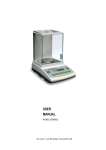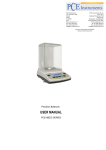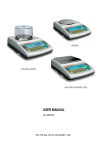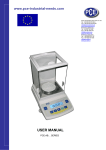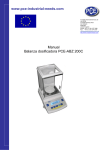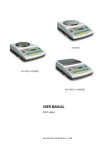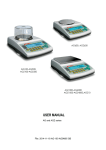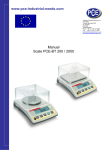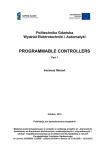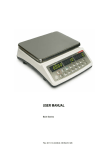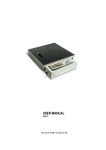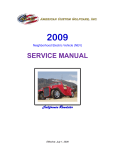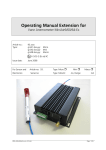Download USER MANUAL
Transcript
USER MANUAL AGN/C SERIES File: ER-AGNC-109-09-07 CE AGC056 2 USER MANUAL ____________________________________________________________________________________________________________________ Contents: 1. General description........................................................................................................ 3 2. Completeness................................................................................................................ 3 3. Security rules ................................................................................................................. 4 4. Technical Data............................................................................................................... 5 5. General view.................................................................................................................. 6 6. Keys and indicators........................................................................................................ 7 7. Preparations – working environment.............................................................................. 8 8. Preparations – the balance ............................................................................................ 9 9. Operation principles ..................................................................................................... 10 10. Balance start-up........................................................................................................... 11 11. Internal calibration ....................................................................................................... 12 12. Connecting a balance to a computer or a printer ......................................................... 12 13. Basic balance functions ............................................................................................... 14 13.1 Normal weighing......................................................................................................... 14 13.2 Weighing with tare ...................................................................................................... 14 14. Special functions description........................................................................................ 15 14.1 Autozeroing (AutotAr) ................................................................................................. 16 14.2 Pieces counting (PCS) ............................................................................................... 17 14.3 External calibration / calibration options (CALIbr) ....................................................... 18 14.4 Serial port setting (rS-232).......................................................................................... 22 14.5 Weighing unit selection (UnIt)..................................................................................... 23 14.6 Function Menu customisation (ACtIV) ........................................................................ 23 15. Maintenance and repairs of small defects.................................................................... 24 Declaration of Conformity ................................................................................................... 25 USER MANUAL 3 ____________________________________________________________________________________________________________________ 1. General description AGN...C series balances are destined for high accuracy weighing in laboratory practice. Balances are equipped with an internal calibration system for proper accuracy control during operation. The user should also own weight standard of OIML F2 or F1 class for periodical control of the balance (weight value stated in Technical Data sheet) - available separately. For purposes where EC verification is not required AGNZ/C without internal calibration circuit balances are appropriated. In those balances all the functions connected with internal calibration are removed (chapters 9, 12 and 14.3). All balances are metrologically tested - calibration on demand. 2. Completeness A standard set consist of: 1. Balance, 2. Tin floor plate and pan ring, 3. Pan support and pan, 4. Feeder ZN 12V/500mA, 5. User Manual, 6. Guarantee card. 4 USER MANUAL ____________________________________________________________________________________________________________________ 3. Security rules To avoid electrical shock or damage of the balance or connected peripheral devices, it is necessary to follow the security rules below. • All repairs and necessary regulations can be made by authorised personnel only. • To avoid fire risk use a feeder of an appropriate type (supplied with the balance). Pay attention that supply voltage is compatible with specified technical data. • Do not use the balance when its cover is opened. • Do not use the balance in explosive conditions. • Do not use the balance in high humidity. • If the balance seems not to operate properly, unplug it from the mains and do not use until checked by authorised service. According to legal regulations it if forbidden to dispose electronic equipment in waste containers. • Please return wasted balance to the point of purchase or other company specialised in recycling of wasted electronic components. 5 USER MANUAL ____________________________________________________________________________________________________________________ 4. Technical Data Type Capacity (Max) Min load (Min) Reading unit (d) Verification unit (e) Tare range Accuracy class Working temperature Weighing time Pan dimension Balance base dim. (including legs) Weighing chamber dimensions Power Balance weight Calibration weight (OIML) AGN50C AGNZ50C 50g 10mg 0,1mg 1mg -50g E2 50g AGN100C AGNZ100C 100g 10mg 0,1mg 1mg -100g I +18 ÷ +30 °C <8s φ90mm 215(235)x345x350mm AGN200C AGNZ200C 200g 10mg 0,1mg 1mg -200g 175x140x230mm ~230V 50Hz 6VA / =12V 300mA 6,5kg E2 100g E2 200g 6 USER MANUAL ____________________________________________________________________________________________________________________ 5. General view Front view: 9 1 2 3 4 8 1 – pan 2 – support pan 3 – pan ring 4 – weighing chamber floor 5 – keyboard 6 – legs 7 – water-level 8 – LCD display 9 – weighing chamber 5 7 6 Rear view: Feeder Adjust switch RS232C 1 ON OFF RxD(receiver) TxD(transmitter) 2 6 7 3 8 4 GND Case 5 9 7 USER MANUAL ____________________________________________________________________________________________________________________ 6. Keys and indicators Max key key key key key key key →T← →0← MENU I/ indicator bar indicator indicator OFF last digit frame Max, Min, d, e, II e d II - tare (subtract package weight from weighed mass) - numeric key / zeroing (balances for direct sale use only), - numeric key / data output (print / transmission), - numeric key / internal calibration on and off, - special function on/off switch, - numeric key / menu, - switch-on/switch-off (standby), - result stabilisation, - load indicator 0 ÷ 100%, - stand-by mode, - informs that reading unit value is lower than allowable indication error (verified balances with d ≠ e) metrological parameters and accuracy class. Additional functions of keys: - next digit, - decimal point, →T← - next position, MENU - end. Min 8 USER MANUAL ____________________________________________________________________________________________________________________ 7. Preparations – working environment +30°C +18°C When choosing a location to set up the balance, remember the following rules to ensure proper working conditions and user-friendly operating: - setup the balance on an even, flat surface leaving necessary room for easy access, - maintain proper working temperature, - avoid strong air drafts, vibrations, dust, big temperature changes and humidity over 75%, - avoid locations with extreme heat radiation and electromagnetic or magnetic fields. USER MANUAL 9 ____________________________________________________________________________________________________________________ 8. Preparations – the balance 1 2 3 4 7 6 1. Take the balance and supplied accessories (a feeder, pan elements) out of the box. 2. Place the balance on a stable ground not affected by mechanical vibrations and airflows. 3. Level the balance with rotating rear legs 6 so that the air bubble in water-level 7 at the back of the balance is in the middle. 4. Place thin floor plate 4 and the pan ring 3 in the weighing chamber and gently put on the pan support 2 and finally the pan 1. 5. Plug a feeder to the 12V power socket at the back of the balance. Moisture in the air may condense on the surface of the balance when transferred to the warmer environment. In this case leave the balance for at least 4 hours unplugged from the mains for conditioning to avoid wrong operating or damage of the balance. 6. Leave the pan empty and plug the feeder to the mains. At the end of selftests, the balance displays zero indication and is now ready to work. 10 USER MANUAL ____________________________________________________________________________________________________________________ 9. Operation principles Do not overload the balance more then 20% of maximum load (Max). Do not press the pan with a hand. Before transportation take off the pan (move it slightly and lift it up) and the pan base and preserve from any damages. 1. To ensure proper weighing accuracy the balance is equipped with internal calibration system (it doesn’t concerne AGNZ/C series). The system automatically calibrates the balance every 2 hours and with temperature changes more than 1°C (values modification possible) without user intervention. When the balance is moved to another localisation remember to level the balance and proceed with internal calibration. 2. To ensure reliable results it is advised to check balance accuracy with a standard weight or an object of precisely known weight before and after each measuring session. In case permissible balance measurement error is exceeded it is advised to do EC verification with external standard weight or contact with an authorised service. 3. Weighed sample should be placed in the centre of the pan. 4. In balances equipped with →0← key and with d=e, make sure that zero indicator is displayed. If not, press →0← key and wait until zero indication and zero indicator appears. In other balances the key does not operate. 5. The balance is equipped with a tare equal to its range. To tare the balance press →T← key (left or right). Storing a tare value does not extend measuring range, but only subtracts it from a load placed on the pan. To make weight control easier and to avoid range overdrawing, the balance is equipped with a load indicator (graduated in percentages). 6. Weighing result should be read when the indicator " " lights, which signalises stabilisation of a result. 7. When the balance is not used but it is necessary to be ready to work immediately, it can be switched off by pressing I/ key. The balance reading system is then switched off to "standby" mode (signalled by the indicator "OFF"). To switch the balance on press I/ key. The balance is immediately ready to operate maximum accuracy (after self tests). 8. The mechanism of the balance is a precise device, sensitive to mechanical strokes and shocks. 9. The balance should not be used to weigh ferromagnetic materials due to accuracy decrease. USER MANUAL 11 ____________________________________________________________________________________________________________________ 10. Balance start-up If pan is empty plug a feeder to the 12V power socket at the back of the balance autotests and calibration procedure begins. Operations sequence after start-up: LCD display test. Electronic circuits tests. Internal calibration drive test (motor sound). Internal calibration beginning. It is possible to omit the calibration by pressing key. Balance program version displaying. After a balance is zeroed it is ready to work. 12 USER MANUAL ____________________________________________________________________________________________________________________ 11. Internal calibration Internal calibration (autocalibration) is performed automatically after each start-up, also in defined time intervals and defined temperature changes (it doesn’t concerne AGNZ/C series). During calibration internal referential weight is automatically put on by balance mechanism and accuracy correction is introduced to balance program. To calibrate the balance with internal weight, simply empty the pan and press twice key. If key is once more pressed the calibration will be aborted. The beginning of internal calibration is signalised with WAIt communicate on the display. 12. Connecting a balance to a computer or a printer The balance may send data to a computer or a printer through RS232C port. When cooperating with the balance, a computer should be equipped with a program which enables processing data from the balance. Computer programs offer is available on the website: www.axis.pl . There is also a freeware program for testing a serial port of the balance. The balance sends weighing result according to SEndInG option settings (RS232C interface configuration function): − after initialising signal from a computer, − automatically after loading a weight on a pan and result stabilisation (Auto), − after pressing key and result stabilisation (b.P Stb), − after pressing key and without result stabilisation (butt.P), − continuously about 10 times per second (cont.). Standard transmission parameters: 8bits, 1stop, no parity, 4800bps. To change transmission parameters use RS232 interface configuration function. USER MANUAL 13 ____________________________________________________________________________________________________________________ Detailed description of the standard data transmission protocol (Long protocol) Computer→Balance: initialising signal S I CR LF (53h 49h 0Dh 0Ah) Balance→Computer: balance indication in the following format (16Bytes) Particular baits description: Byte Byte Byte Byte Byte Byte Byte Byte Byte 1 2, 11 and 14 3÷4 5÷9 10 12 13 15 16 - sign or space space digit or space digit, decimal point or space digit k, l, c, p or space g, b, t, c or % CR (0Dh) LF (0Ah) Connection cable WK-1 (balance – computer / 9-pin): BALANS COMPUTER Connection cable WD-1 (balance - KAFKA printer): BALANS PRINTER KAFKA printer internal switches set-up: SW-1 on SW-2 off SW-3 SW-4 SW-5 SW-6 SW-7 SW-8 on off off on off off 14 USER MANUAL ____________________________________________________________________________________________________________________ 13. Basic balance functions In further part of this manual the following graphical symbols will be used for balance functions description. - press a key - balance indication 1.0234 g - forced change - automatic change 13.1 Normal weighing When the pan is empty and indication is different than zero press →T← key. 0.0000g T Attention: In balances for direct trade (option) press →0← key to zero a balance with empty pan, →T← key works only when there is a weight on a pan and its mass is taken as a tare. 1.0234g Weighing result should be read when the indicator " " lights. 13.2 Weighing with tare 1.0203g 0.0000g 2.0004 g T When →T← key is pressed a tare of a packaging is stored in a balance memory. In further weighing stored value is subtracted from a mass placed on a balance pan. The balance enables taring in a full weighing range. After tare is stored weighing range is accordingly decreased. USER MANUAL 15 ____________________________________________________________________________________________________________________ 14. Special functions description All balances, beside basic functions like weighing and tare, are equipped with the set of additional functions. Standard set of special functions includes: - pieces counting, - autozeroing, - serial port parameters setting, - calibration options - weighing unit change (grams / carats / pounds) Other special functions may be enabled as an option on customer request (described in additional brochure). After MENU key is pressed functions menu is displayed. Functions are displayed in the order: AutotAr, PCS, etc. For easy access to the most frequently used functions, use ACtIV function to select functions to be displayed in functions menu. While special functions setting MODE indicator is displayed. 16 USER MANUAL ____________________________________________________________________________________________________________________ 14.1 Autozeroing (AutotAr) When AutotAr function is activated, the balance automatically ensures stable zero indication if the pan is empty or if zero indication was acquired by pressing →T← key. 0.0000g MENU AutotAr T Aut on T 0.0000g Function has options: - Aut on – activation - Aut oFF – deactivation - Aut SEt - maximum zero flow to automatic correction - out – exit from setting Choosing Aut Set enables to set value of maximum zero flow with the following keys: - increment digit, - decimal point, →T← - next position, MENU – end. While AutotAr function is active at the top of a display AUT caption is visible. To deactivate the function press MENU key and with →T← key choose AutotAr and Aut oFF. Note: Autozeroing function is activated automatically for 10 min. after switching-on. USER MANUAL 17 ____________________________________________________________________________________________________________________ 14.2 Pieces counting (PCS) 0.0000 g T 0.1204 g MENU 5 PCS PCS on T T PCS PCS 5 5 pcs 0 pcs 12 12 pcs This function enables to count identical pieces, e.g. turnbuckles or buttons in weighed portion. A measurement is performed in two phases: - first phase - single piece weight calculation on the basis of defined pieces amount: 5, 10, 20, 50, 100, 200 or 500 pieces, set pieces amount (SEt) or mass of the single unit (uM). - second phase – counting of a pieces in portion. It is advised that single piece weight is greater than one reading unit and sample weight used in first phase is greater than 100 reading units. To leave function press MENU key and then with →T← key choose PCS and PCS oFF. T Note: PCS-Err communicate signalises that a sample was not put on the pan or a single piece weight is less than one reading unit (it is possible to count pieces but measuring error is bigger). To choose previously used pieces amount select “. .” in first phase. Choosing PCS Set enables to write pieces amount in weighed portion, and PCS uM – to write unitary mass with the following keys: - increment digit, - decimal point, →T← - next position, MENU – end. 18 USER MANUAL ____________________________________________________________________________________________________________________ 14.3 External calibration / calibration options (CALIbr) Calibration with external weight standard in verified balances should be performed in case balance indications exceed permissible error. To calibrate the balance a service centre should use calibration weight as stated in Technical Data table (or of better accuracy) with valid calibration certificate. Calibration of verified balance should be done by authorized service, because it is connected with infringing protective marks and another balance in the nearest Notified Body or in the place where it works. In balances with EC verification calibration function is blocked for the user. It is only possible to print calibration report useful for routine balance check-through. To calibrate verified balance change position of adjustment switch which is placed under protective mark (label) of Notified Body. An access to this switch is allowed only after the mark is removed. Therefore, balance calibration causes loosing of EC verification and in consequence the need of another verification in the nearest Notified Body or in the place where it works. Adjustment switch ON Mark OFF Before calibration of verified balance with a thin screwdriver change adjustment switch to ON position (it is signalised on the display with Pr on message). After calibration process, which is described on the next page, is finished the balance displays Pr on message. With a thin screwdriver change adjustment switch to OFF position (balances goes to weighing). 19 USER MANUAL ____________________________________________________________________________________________________________________ Operations sequence in balance calibration: 0.0000g MENU Press MENU to call special functions menu. CALIbr T CAL on T m1 Press →T← while CALIbr is displayed. Calibration function options: - CAL oFF – turn calibration off - CAL on – start calibration with external weight - CAL Prn – print calibration report - CAL tM – set time interval between successive autocalibrations - CAL °C - set temperature difference which exceeded starts autocalibration m2 Press →T← while CAL on is displayed. m Wait for displaying mass value of a weight used in calibration, press key to accelerate scrolling mass values. Press →T← to choose mass of a weight. ... T CAL m -------- Wait until zeroing process is finished. LOAD When LOAD communicate a calibration weight on the pan. put CAL unLOAD WAIt -------0.0000g When unLOAD communicate appears remove the calibration weight from the pan. Wait until finished. internal calibration Wait until zeroing process is finished. is 20 USER MANUAL ____________________________________________________________________________________________________________________ Calibration options Internal calibration (autocalibration) is performed automatically after each start-up, also in defined time intervals and after temperature changes more than defined value (it doesn’t concerne AGNZ/C series). CALIbr function enables to set time and temperature difference value for autocalibration. Press MENU key to call functions menu 0.0000g MENU and to choose CALIbr with →T← key. CALIbr T CAL oFF ... CAL tM T When CAL tM is displayed press →T← key. Successive time interval values appears, to accelerate press key several times. 1h ... 2h T CAL o C T 0.5 o o C C out Choose required value with →T← key. Similarly, when CAL °C is displayed, press →T← key and select temperature difference value. ... 1.0 Calibration function options: - CAL oFF – turn calibration off - CAL on – start calibration with external weight - CAL Prn – print calibration report - CAL tM – set time interval between successive autocalibrations - CAL °C - set temperature difference which exceeded starts autocalibration T T To finish select out. Choose CAL oFF to turn calibration off. 0.0000g USER MANUAL 21 ____________________________________________________________________________________________________________________ The report printout example Date : ... Time.: ... Calibration report ---------------------------------------------------Date of production Serial number Program version Adjustation no. Factory external weight Factory internal weight Current external weight Current internal weight Weight difference : : : : : : : : : ... ... ... ... ... ... ... ... ... - internal and external weight mass used in factory calibration - internal and external weight mass used in last calibration - the difference between internal weight mass 22 USER MANUAL ____________________________________________________________________________________________________________________ 14.4 Serial port setting (rS-232) 0.000g MENU rS-232C bAud T T -4800 Function allows to set the following RS232C interface parameters: - speed (bAud), - bits (bit), - parity control (PArItY), - protocol (Prot) - transmission kind (SEndInG). To set RS-232 parameter values turn rS-232 function on, choose required parameter and while a desired parameter value or an option is displayed press →T← key. T As an example (see on the left) setting 9600bps of the transmission speed is shown. The rest of the parameters is set similarly. bItS T After interface parameters are set choose out to exit. PArItY T SEndInG T out T -9600 USER MANUAL 23 ____________________________________________________________________________________________________________________ 14.5 Weighing unit selection (UnIt) 1.6000g MENU UnIt T - carats (1 ct= 0,2 g), - pounds (1 lb=0,454kg), - grams. The example on the left presents how to set carats as a weighing unit. CArAt 8.0000 Function allows to choose weighing unit: T ct 14.6 Function Menu customisation (ACtIV) 0.00 ACtIV T This function enables to select special functions that will be displayed after pressing MENU key. Easy access to the most useful functions will shorten operation time and make work more comfortable. To differ ActIV function from the function menu, indicator is displayed at the left side of the display. AUtOtAr Operation sequence shown on the picture, presents how to add RS232C parameters setting function (rS-232) to the functions menu. rS232 T rS oFF rS on T To remove a function from the functions menu choose rS oFF in the last operation. 24 USER MANUAL ____________________________________________________________________________________________________________________ 15. Maintenance and repairs of small defects 1. The balance should be kept clean. 2. Take care that no dirt gets between a casing and the pan. If found any, remove the pan (lift it up), remove dirt and then replace the pan. 3. In case of improper operation caused by short-lasting power supply decay, unplug the balance from the mains and then plug it again after few seconds. 4. To calibrate the balance contact nearest service. 5. It is forbidden to make any repairs by unauthorised persons. 6. To repair the balance, please contact our nearest service. The list of authorised services is placed in a guarantee card. Error communicates: Communicate Possible cause selftests failed if displayed more than 1 minute, contact an authorised service pan missing put the pan on mechanical damage contact an authorised service overloading remove the load from the pan mechanical damage contact an authorised service C-1 ... 6 (over 1 min.) L H unstable ground vibrations indicator does air flows not appear balance damage ------ Remedy taring in progress place the balance on a stable ground not affected by mechanical vibrations and airflows contact an authorised service as above 25 USER MANUAL ____________________________________________________________________________________________________________________ Declaration of Conformity We: AXIS Spółka z o.o. 80-125 Gdańsk, ul.Kartuska 375B confirm with all responsibility that balances: AGN50C, AGN100C, AGN200C, AGNZ50C, AGNZ100C, AGNZ200C marked with CE mark comply with the following: 1. EN 55022 standard Limits and methods of measurement of radio disturbance characteristics of information technology equipment and IEC 61000-4-3 Electromagnetic compatibility (EMC) - Part 4-3: Testing and measurement techniques - Radiated, radio-frequency, electromagnetic field immunity test, harmonised with the Council Directive 89/336/EEC. Additionally balances with following marking on the name plate: - a sticker with two-digit number of the year in which the mark was affixed and the number of the Notified Body - a green metrology sticker with “M” mark xx - a protective seal affixed by the Notified Body comply with requirements stipulated on the Type-Approval Certificate TCM 128/07-4511 and for verification to comply with: 2. En 45501 Metrological aspects of non-automatic weighing instruments harmonised with the Council Directive 90/384/EEC amended with 93/68/EEC. Additional information - Conformity evaluation for the Council Directive 89/336/EEC were carried out by Laboratorium Badawcze Oddziału Instytutu Elektrotechniki w Gdańsku - Type-Approval Certificate no. TCM 128/07-4511 was issued by Česky Metrologicky Institut Brno (Notified Body no. 1383). Gdańsk, 21.03.2007 Per pro Director of AXIS Ltd: Production Manager Jan Kończak _________________ Signature 26 USER MANUAL ____________________________________________________________________________________________________________________ USER MANUAL 27 ____________________________________________________________________________________________________________________ Notes 28 USER MANUAL ____________________________________________________________________________________________________________________




























